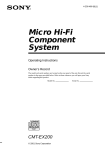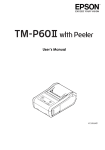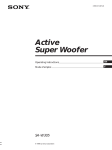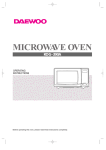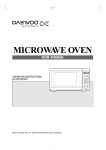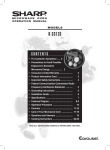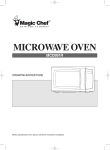Download Daewoo KOM-9F85 Operating instructions
Transcript
MICROWAVE OVEN KOM-9F85 / KOM-9F50 OPERATING INSTRUCTIONS FOR COMMERCIAL USE Before operating this oven, please read these instructions completely. PRECAUTIONS TO AVOID POSSIBLE EXPOSURE TO EXCESSIVE MICROWAVE ENERGY (A) DO NOT ATTEMPT TO OPERATE THIS OVEN WITH THE DOOR OPEN SINCE OPENDOOR OPERATION CAN RESULT IN HARMFUL EXPOSURE TO MICROWAVE ENERGY. IT IS IMPORTANT NOT TO DEFEAT OR TAMPER WITH THE SAFETY INTERLOCKS. (B) DO NOT PLACE ANY OBJECT BETWEEN THE OVEN FRONT FACE AND THE DOOR OR ALLOW SOIL OR CLEANER RESIDUE TO ACCUMULATE ON SEALING SURFACES. (C) WARNING: IF THE DOOR OR DOOR SEALS ARE DAMAGED, THE OVEN MUST NOT BE OPERATED UNTIL IT HAS BEEN REPAIRED BY A COMPETENT PERSON; (1) DOOR (BENT), (2) HINGES AND LATCHES(BROKEN OR LOOSENED), (3) DOOR SEALS AND SEALING SURFACES. (D) WARNING: IT IS HAZARDOUS FOR ANYONE OTHER THAN A COMPETENT PERSON TO CARRY OUT ANY SERVICE OR REPAIR OPERATION THAT INVOLVES THE REMOVAL OF A COVER WHICH GIVES PROTECTION AGAINST EXPOSURE TO MICROWAVE ENERGY: (E) WARNING: ONLY ALLOW CHILDREN TO USE THE OVEN WITHOUT SUPERVISION WHEN ADEQUATE INSTRUCTIONS HAVE BEEN GIVEN SO THAT THE CHILD IS ABLE TO USE THE OVEN IN A SAFE WAY AND UNDERSTANDS THE HAZARDS OF IMPROPER USE. (F) WARNING: WHEN THE APPLIANCE IS OPERATED IN THE COMBINATION MODE, CHILDREN SHOULD ONLY USE THE OVEN UNDER ADULT SUPERVISION DUE TO THE TEMPERATURE GENERATED. (G) WARNING: LIQUIDS AND OTHER FOODS MUST NOT BE HEATED IN SEALED CONTAINERS SINCE THEY ARE LIABLE TO EXPLODE: (H) WARNING: MICROWAVE HEATING OF BEVERAGES CAN RESULT IN DELAYED ERUPTIVE BOILING, THEREFORE CARE MUST BE TAKEN WHEN HANDLING THE CONTAINER; (I) WARNING: THE CONTENTS OF FEEDING BOTTLES AND BABY FOOD JARS MUST BE STIRRED OR SHAKEN AND THE TEMPERATURE CHECKED BEFORE CONSUMPTION, IN ORDER TO AVOID BURNS; 1 TABLE OF CONTENTS PRECAUTIONS TO AVOID POSSIBLE EXPOSURE TO EXCESSIVE MICROWAVE ENERGY.....1 TABLE OF CONTENTS......................................................................................................................2 INSTALLATION ..................................................................................................................................3 EARTHING INSTRUCTIONS .............................................................................................................4 SPECIFICATIONS..............................................................................................................................5 IMPORTANT.......................................................................................................................................5 IMPORTANT SAFETY INSTRUCTIONS............................................................................................6 FEATURES DIAGRAM.......................................................................................................................7 FEATURES DIAGRAM (continued)...................................................................................................8 OPERATION PROCEDURE...............................................................................................................9 CONTROLS......................................................................................................................................10 Manual Cooking...........................................................................................................................10 Preprogrammed Pads..................................................................................................................11 Double Quantity ...........................................................................................................................12 Programming Pads ......................................................................................................................13 Programming Cook Factor...........................................................................................................14 20 sec.+ pad ................................................................................................................................15 Changing User Options ...............................................................................................................16 COOKING INSTRUCTIONS.............................................................................................................17 MICROWAVING PRINCIPLES.........................................................................................................18 HOW MICROWAVES COOK FOOD ................................................................................................18 CONVERSION CHARTS..................................................................................................................18 COOKING TECHNIQUES ................................................................................................................19 CARING FOR YOUR MICROWAVE OVEN .....................................................................................20 CARE AND CLEANING....................................................................................................................20 CLEANING THE CEILING COVER ..................................................................................................21 CLEANING THE AIR FILTER...........................................................................................................21 USE YOUR MICROWAVE OVEN SAFELY .....................................................................................22 ARCING ...........................................................................................................................................22 BEFORE YOU CALL FOR SERVICE...............................................................................................23 QUESTIONS AND ANSWERS.........................................................................................................23 QUESTIONS AND ANSWERS (continued).....................................................................................24 DISPOSAL OF USED ELECTRICAL & ELECTRONIC EQUIPMENT..............................................24 2 INSTALLATION 1 Steady, flat location This oven should be set on a steady, flat surface. This oven is designed for counter top use only. 2 Leave space behind and side All air vents should be kept a clearance. If all vents are covered during operation, the oven may overheat and, eventually, oven failure. 3 Away from radio and TV sets Poor television reception and radio interference may result if the oven is located close to a TV, Radio antenna, feeder and so on. Position the oven as far from them as possible. 4 Away from heating appliance and water taps Keep the oven away from hot air, steam or splash when choosing a place to position it, or the insulation might be adversely affected and breakdowns occur. 5 Power supply • Check your local power source. This oven requires a current of approximately 13 Amperes, 240V 50Hz. • Power supply cord is about 1.7 meters long. • The voltage used must be the same as specified on this oven. Using a higher voltage may result in a fire or other accident causing oven damage. Using low voltage will cause slow cooking. We are not responsible for damage resulting from use of this oven with a voltage of ampere fuse other than those specified. • If the supply cord is damaged, it must be replaced by the manufacturer or its service agent or a similarly qualified person in order to avoid a hazard. 6 Examine the oven after unpacking for any damage such as: A misaligned door, Broken door, A dent in cavity. If any of the above are visible, DO NOT INSTALL, and notify dealer immediately. 7 Do not operate the oven if it is colder than room temperature. (This may occur during delivery in cold weather.) Allow the oven to become room temperature before operating. 8 The minimum height of free space necessary above the top surface of the oven is 150mm. 3 9. When you stack your micowave ovens. 1) Place one microwave oven on top of the other one, and remove the plate which are each secured by a single screw to the bottom-right corner at the rear of both microwaves. Secure the above hole of the two microwaves. 2) Remove the two screws which are securing at both end of the cabinet of the lower microwave oven. Remove the two screws which is securing the bottom corner of the upper micowave oven. 3) Use the upper and lower plate screw holes to secure the upper and lower microwave ovens with the four screws. 4) Ensure the top oven is at a safe and workable height. EARTHING INSTRUCTIONS This appliance must be earthed. In the event of an electrical short circuit, earthing reduces the risk of electric shock by providing an escape wire for the electric current. This appliance is equipped with a cord having a earthing wire with a earthing plug. The plug must be plugged into an outlet that is properly installed and earthed. WARNING : Improper use of the earthing plug can result in a risk of electric shock. Consult a qualified electrician or serviceman if the earthing instructions are not completely understood, or if doubt exists as to whether the appliance is properly earthed. If it is necessary to use an extension cord, use only a 3-wire extension cord that has a 3blade earthing plug, and a 3-slot receptacle that will accept the plug on the appliance. The marked rating of the extension cord should be equal to or greater than the electrical rating of the appliance. 4 SPECIFICATIONS KOM-9F85 MODEL 240V AC 50Hz SINGLE PHASE WITH EARTHING POWER SUPPLY MICROWAVE KOM-9F50 POWER CONSUMPTION 3000W 2600W OUTPUT POWER 1850W 1500W 2450MHz 2450MHz APPROX. 34kg (75.1lbs) APPROX. 32.5kg (71.7lbs) FREQUENCY NET. WEIGHT OUTSIDE DIMENSIONS (W X H X D) 465 X 370 X 599 mm ( 18.31 X 14.57 X 23.58 in.) CAVITY DIMENSIONS (W X H X D) 371 X 198.5 X 372 mm ( 14.61 X 7.81 X 14.66 in.) 60 min. TIMER 5 LEVELS POWER SELECTIONS * Specifications are subject to change without notice. 599 370 465 IMPORTANT The wires in this mains lead fitted to this appliance are coloured in accordance with the following code. Green-and-yellow : Earth Blue : Neutral Brown : Live As the colours of the wires in the mains lead of this appliance may not correspond with the coloured markings identifying the terminals in your plug, proceed as follows: the wire which is coloured green-andyellow must be connected to the terminal in the plug which is marked with the letter 'E', the earth symbol or coloured green-and-yellow. The wire which is coloured blue must be connected to the terminal which is marked with the letter ‘N’ or coloured black. The wire which is coloured brown must be connected to the terminal which is marked with the letter 'L' or coloured red. WARNING: This appliance must be earthed. 5 IMPORTANT SAFETY INSTRUCTIONS READ CAREFULLY AND KEEP FOR FUTURE REFERENCE WARNING : To prevent fire, burns, electric shock and other warnings: Listed below are, as with all appliances, certain rules to follow and safeguards to assure high performance from this oven: 1. Do not use the oven for any reason other than food preparation, such as for drying clothes, paper, or any other nonfood items or for sterilizing purposes. 2. Do not use the oven when empty, this could damage the oven. 3. Do not use the oven cavity for any type of storage, such as papers, cookbook, cookware, etc. 4. Do not cover the rear ventilation slot with cloth or paper. 5. Make sure you remove caps or lids prior to cooking when you cook food sealed in bottles. 6. Do not put foreign material between the oven surface and door. It could result in excessive leakage of microwave energy. 7. Do not use recycled paper products for cooking. They may contain impurities which could cause sparks and/or fires when used during cooking. 8. Do not pop popcorn unless popped in a microwave approved popcorn popper or unless it's commercially packaged and recommended especially for microwave ovens. Microwave popped corn produces a lower yield than conventional popping; there will be a number of unpopped kernels. Do not use oil unless specified by the manufacturer. 9. Do not cook any food surrounded by a membrane, such as egg yolks, potatoes, chicken livers, etc., without first piercing them several times with a fork. 10. Do not pop popcorn longer than the manufacturer's directions. (popping time is generally below 2 minutes). Longer cooking does not yield more popped corn, it can cause scorchings and fire. Also, the cooking tray can become too hot to handle or may break. 11. If smoke is observed, switch off or unplug the appliance and keep the door closed in order to stifle any flames. 12. When heating food in plastic or paper containers, keep an eye on the oven due to the possibility of ignition. 13. The contents of feeding bottles and baby food jars shall be stirred or shaken and the temperature checked before consumption, in order to avoid burns. 14. Always test the temperature of food or drink which has been heated in a microwave oven before you give it to somebody, especially to children or elderly people. This is important because things which have been heated in a microwave oven carry on getting hotter even though the microwave oven cooking has stopped. 15. Eggs in their shell and whole hard-boiled eggs should not be heated in microwave ovens since they may explode, even after microwave heating has ended; 16. Keep the waveguide cover clean at all times. Wipe the oven interior with a soft damp cloth after each use. If you leave grease or fat anywhere in the cavity it may overheat, smoke or even catch fire when next using the oven. 17. Never heat oil or fat for deep frying as you cannot control the temperature and doing so may lead to overheating and fire. 18. Liquids, such as water, coffee, or tea are able to be overheated beyond the boiling point without appearing to be boiling due to surface tension of the liquid. Visible bubbling or boiling when the container is removed from the microwave oven is not always present. THIS COULD RESULT IN VERY HOT LIQUIDS SUDDENLY BOILING OVER WHEN A SPOON OR OTHER UTENSIL IS INSERTED INTO THE LIQUID. To reduce the risk of injury to persons: a) Do not overheat the liquid. b) Stir the liquid both before and halfway through heating it c) Do not use straight-sided containers with narrow necks. d) After heating, allow the container to stand in the microwave oven for a short time before removing the container. e) Use extreme care when inserting a spoon or other utensil into the container. 19. Oven should be cleaned regularly and any food deposits removed. 20. Failure to maintain the oven in a clean condition could lead to deterioration of the surface that could adversely affect the life of the appliance and possibly result in a hazardous situation. 21. This appliance is not intended for use by persons(including children) with reduced physical, sensory or mental capabilities, or lack of experience and knowledge, unless they have been given supervision or instruction concerning use of the appliance by a person responsible for their safety. 22. Children should be supervised to ensure that they do not play with the appliance. SAVE THESE INSTRUCTIONS 6 FEATURES DIAGRAM 3 2 4 5 6 1 Safety Interlock System. 1 7 8 5 Door Seal - Door seal maintains the microwave energy within the oven cavity and prevents microwave leakage. 2 Door Viewing Screen - Allows viewing of food. The screen is designed so that light can pass through, but not microwaves. 6 Plate Tray - Made of special heat resistant material. Food in a proper receptacle is placed on this plate for cooking. 3 Door Hook - When door is closed, it will automatically shut off. If the door is opened while the oven is operating, magnetron will immediately stop operating. 7 Ceiling Cover - This is located on top side of the oven. 4 Oven Cavity. 8 Air Filter 7 FEATURES DIAGRAM (continued) 2 1 3 45 6 7 1 MICROWAVE indicator Lights when the microwave is operation. 8 9 0 8 DOUBLE QUANTITY pad X2 pad increases a preprogrammed cooking time by a percentage of the original cooking time. The user specifies the percentage and it can be changed for individual cooking sequences. This feature is very useful for cooking multiple servings of foods. 2 Double Quantity indicator Lights when DOUBLE QUANTITY pad is pressed. 3 STAGE indicator Indicates which STAGE of mult-stage cooking is in progress 9 STOP pad STOP pad stops a cooking sequence in progress, clears out any remaining time, and also ends programming or user option cycle. When STOP pad is used to end a programming or option change, the changes are discarded. 4 CLEAN FILTER indicator Will display when the filter needs cleaning. 5 POWER LEVEL indicator It will turn on when POWER LEVEL pad is pressed unless at full power. 6 POWER LEVEL pad POWER LEVEL pad is used to set a variable power level. 0 START/ 20sec.+ pad START pad is used to begin a manual cooking cycle. It is also used to save any changes to programming sequences or user options. START pad can be used as speedy cooking pad. In ready mode, 20sec.+ pad allows you to reheat for 20 seconds at full power by pressing it. By repeatedly touching 20sec.+ pad, you can also extend reheating time to 5 minutes by 20 second increments. 7 Number pads Number pads are used to set the manual cooking time. It is also used to start preprogrammed cooking cycle. 8 OPERATION PROCEDURE This section includes useful information about oven operation. 1. Plug power supply cord into a standard 240V AC 50Hz power outlet. 2. After placing the food in a suitable container, open the oven door and put it in the oven. 3. Shut the door. Make sure that it is firmly closed. 4. Set required programme and time, then touch stert. 5. Once cooking is complete, take care removing container as it will be hot. oven light is on when the microwave oven 1 The is operating or the door is opened. STOP pad is touched during the oven 7 When operation, the oven stops cooking and all The oven door can be opened at any time during operation by opening the door. The oven will automatically stop working. information retained. To erase all information, touch STOP pad once more. If the oven door is opened during the oven operation, all information is retained. time a pad is touched, a BEEP will sound 3 Each to acknowledge the touch. START pad is touched and the oven does not 8 Ifoperate, check the area between the door and 2 4 door seal for obstructions and make sure the door is closed securely. The oven will not start cooking until the door is completely closed or the program has been reset. The oven automatically cooks at full power unless set to a lower power level. segments of the display will turn on when the 5 All oven door is closed and it is first plugged in. the oven is just plugged in at first or the 6 When display is turned off, the key pads are not Make sure the oven is properly installed and plugged into the electrical outlet. activated. After oven door is opened and closed once, the oven is ready to work showing "HELLO" shows in the display. WATTAGE OUTPUT CHART • A power level is selected by touching the POWER LEVEL pad. The chart shows the display, the power level and the percentage of power. POWER LEVEL pad. Power Level (Display) Approximate Percentage of Power once HI 100% twice 70% 70% 3 times 50% 50% 4 times 20% 20% 5 times 00% 0% 9 CONTROLS Manual Cooking To cook food manually using a specific entered cook time and power level. 1. Open the door and put food in the oven. Close the door. • "HELLO" will show in the display. 2. Press POWER LEVEL pad. • If "HI" shows in the display, the power level is adjusted to full power. • The % indicator will light if a lower power level is adjusted. • You can change a power level to adjust desired setting by pressing POWER LEVEL pad repeatedly. 3. Press number pads for entering the cooking time. • You can enter the maximum cooking time up to 60 minutes or 10 minutes. • To change maximum cooking time option, see User Options section in this manual. 4. If stage cooking is desired, repeat step 2 and 3. • Display changes to cook time and power level for the next stage. • Up to three different stages can be programmed. 5. Press START pad. • The oven lamp will turn on and heating will start. • The first STAGE indicator will start to blink and heating time will count down. NOTE Repeat Feature : The user can repeat exactly the same MANUAL COOKING by pressing only START pad, if you use the oven again within keypad activating time. After a MANUAL COOKING is ended, opening and closing the door will make the display show the same cook time and power level setting of the previous MANUAL COOKING. See User Options section in this manual. NOTE The cooling fan may automatically run for a while to cool the oven down after working. 10 Preprogrammed Pads To cook food using number pads preprogrammed with cooking sequences. 1. Open the door and put food in the oven. Close the door. • "HELLO" will show in the display. 2. Press a desired number pad. • For single digit entry, press only one number pad. • For multiple digit entry, press from one to three pads one by one. • To change single or multiple digit entry option, see User Options section in this manual. NOTE You can enter the number of a programmed cook from 0 to 9 by pressing only one number pad in single digit entry mode. You can enter the number of a programmed cook from 0 to 199 by pressing from one to three number pads one by one in multiple digit entry mode. 3. Oven begins to cook. • The oven lamp will turn on and heating will start. • The first STAGE indicator will start to blink and heating time will count down. ■ Factory Setting Pad Cooking time Power Level 1 10 sec. 100% 2 20 sec. 100% 3 30 sec. 100% 4 5 45 sec. 1 min. 100% 100% 6 7 1 min. 30 sec. 2 min. 100% 100% 8 9 0 3 min. 4 min. 5 min. 100% 100% 100% NOTE The cooling fan may automatically run for a while to cool the oven down after working. 11 Double Quantity To increase cooking time when cooking more than one serving. 1. Open the door and put food in the oven. Close the door. • "HELLO" will show in the display. 2. Press X2 pad. • Amount of time added is a percentage of the original preprogrammed cooking time. • The percentage can be changed. See Programming Cook Factor section in this manual. 3. Press desired preprogrammed pad. 4. Oven begins to cook. • The oven lamp will turn on and heating will start. • The first STAGE indicator will start to blink and heating time will count down. NOTE The cooling fan may automatically run for a while to cool the oven down after working. 12 Programming Pads To change the amount of time or the power level for a preprogrammed pad. 1. Open the door. • Display turns off. 2. Press and hold POWER LEVEL pad for a while. • When the oven enters Programming mode, it will show "PROGRAM" in the display. 3. Press number pads to be programmed. • It will show a program number in the display. • For single digit entry, press only one number pad. • For multiple digit entry, press from one to three pads one by one. 4. Press POWER LEVEL pad to select a desired power level. • If "HI" shows in the display, the power level is adjusted to full power. • The % indicator will light if a lower power level is adjusted. • You can change a power level to adjust desired setting by pressing POWER LEVEL pad repeatedly. 5. Enter desired cooking time by using number pads. 6. If stage cooking is desired, repeat step 4 and 5. • Display changes to cook time and power level for the next stage. • Up to three different stages can be programmed. 7. Press START pad to save the program changes. • To discard changes, press STOP pad. 13 Programming Cook Factor To change cook factor for a preset pad. 1. Open the door. • Display turns off. 2. Press and hold POWER LEVEL pad for a while. • When the oven enters Programming mode, it will show "PROGRAM" in the display. 3. Press number pads to be programmed. • It will show a program number in the display. • For single digit entry, press only one number pad. • For multiple digit entry, press from one to three pads one by one. 4. Press X2 pad to change a cooking factor. • It will show the current cook factor. • Factory setting for cook factor is 80%. (CF:80 in the display) 5. Enter desired cook factor by using number pads. (0~9) • Number 1 pad for 10% of cook factor through number 0 pad for 100% of cook factor. 6. Press START pad to save the cook factor changes. • To discard changes, press STOP pad. 14 20 sec.+ pad This function allows you to reheat for 20 seconds at full power by simply touching the 20 sec.+ pad. By repeatedly touching 20 sec.+ pad, you can also extend reheating time to 5 minutes by 20 second increments. 1. Open the door and put food in the oven. Close the door. • "HELLO" will show in the display. 2. Press 20 sec.+ pad. • When you press 20 sec.+ pad, " :20" shows in the display. • The oven will start immediately. It will add 20 seconds to the time counting down each time the pad is pressed. NOTE The cooling fan may automatically run for a while to cool the oven down after working. 15 Changing User Options User Options can be changed to suit individual preferences. 1. Open the door. • Display turns off. 2. Press and hold STOP pad for a while. • When the oven enters Option Code mode, it will show "CODE---" in the display. 3. Press two number pads in order for a two digit option code. For example, if you want to choose "CODE 1-0" from the cook ending signal list, press number 1 pad and number 0 pad in order. 4. Press START pad to save changes. • To change additional option codes, repeat steps 3 and 4. ■ User Options Table Option Code Setting Description (Factory default setting in bold) Cook Ending Signal CODE 1-0 CODE 1-1 CODE 1-2 CODE 1-3 CODE 1-4 CODE 2-0 CODE 2-1 CODE 3-0 CODE 3-1 CODE 4-0 CODE 4-1 CODE 5-0 CODE 5-1 CODE 6-0 CODE 6-1 CODE 6-2 CODE 6-3 CODE 7-0 CODE 7-1 CODE 8-0 CODE 8-1 CODE 9-0 CODE 9-1 CODE 0-0 CODE 0-1 CODE 0-2 CODE 0-3 CODE 0-4 3 long beeps for 3 seconds 1 short, 1 long beeps for 3 seconds 3 second beep 3 quick beeps for 3 seconds 5 quick beeps for 3 seconds A key pad will beep when it is pressed. No beep when a key pad is pressed. The oven will beep when stage cook changes to the next stage. No beep when a key pad is pressed. Maximum Cooking Time is 60 minutes. Maximum Cooking Time is 10 minutes. 10 preprogrammed cooks for key pads (0~9) 200 preprogrammed cooks for key pads (0~199) Display will turn off if a key isn't entered in 1 minute. Display will turn off if a key isn't entered in 2 minute. Display will turn off if a key isn't entered in 3 minute. Display will turn off if a key isn't entered in 4 minute. Repeat feature not allowed. Repeat feature is allowed. No END message after finishing a cooking. END message will be left on the display during display-on time. A user may use preprogrammed pads and manual time cook. A user may use preprogrammed pads only. Clean filter message will show up for 24 hours every 90 days. Clean filter message will show up for 24 hours every 60 days. Clean filter message will show up for 24 hours every 30 days. Clean filter message will show up for 24 hours every 10 days. The oven will not display clean filter message. Key Pad Beep On/Off Stage Cook Change Beep On/Off Maximum Cooking Time Preprogrammed Cook Display OFF Time Counter Repeat Feature COOK END message Reminder Manual Time Cook Lock Clean Filter Reminder ■ How to shut off the clean filter reminder • It will stop displaying automatically after 24 hours. • Or it will be able to be shut off by pressing and holding stop pad for a while until a long beep sounds in idle mode with the closed oven door. 16 COOKING INSTRUCTIONS Utensil Guide Only use utensils that are suitable for use in microwave ovens. To cook food in the microwave oven, the microwaves must be able to penetrate the food, without being reflected or absorbed by the dish used. Care must therefore be taken choosing the utensil. If the utensil is marked microwave-safe, you do not need to worry. The following table lists various of utensil and indicates whether and how they should be used in a microwave oven. Utensil Safe Comments Aluminium foil ▲ Can be used in small quantities to protect areas against overcooking. Arcing can occur if the foil is too close to the oven wall or if too much foil is used. Crust plate ● Do not preheat for more than 8minutes. China and earthenware ● Porcelain, pottery, glazed earthenware and bone china are usually suitable, unless deco-rated with a metal trim. Disposable polyester cardboard dishes ● Some frozen foods are packaged in these dishes. Fast-food packaging • Polystyrene cups containers ● • Paper bags or newspaper • Recycled paper or metal trims ✕ ✕ Can be used to warm food. Overheating may cause the polystyrene to melt. May catch fire. May cause arcing. Glassware • Oven-to-table ware • Fine glassware ● ● • Glass jars ● Metal • Dishes • Freezer bag twist ties ✕ ✕ May cause arcing or fire. ● For short cooking times and warming. Also to absorb excess moisture. May cause arcing. Paper • Plates, cups, napkins and Kitchen paper • Recycled paper ✕ Plastic • Containers ● • Cling film ● • Freezer bags ▲ Wax or grease-proof paper ● Can be used, unless decorated with a metal trim. Can be used to warm foods or liquids. Delicate glass may break or crack if heated suddenly. Must remove the lid. Suitable for warming only. Particularly if heat-resistant thermoplastic. Some other plastics may warp or discolour at high temperatures. Do not use Melamine plastic. Can be used to retain moisture. Should not touch the food. Take care when removing the film as hot steam will escape. Only if boilable or oven-proof. Should not be airtight. Prick with a fork, if necessary. Can be used to retain moisture and prevent spattering. ● : Recommended use ▲ : Limited Use ✕ : Not Recommended 17 MICROWAVING PRINCIPLES Microwave energy has been used in this country to cook and reheat food since early experiments with RADAR in World War ll. Microwaves are present in the atmosphere all the time, both naturally and manmade sources. Manmade sources include radar, radio, television, telecommunication links and car phones. HOW MICROWAVES COOK FOOD Microwave oven is a Group 2 ISM equipment in which radiofrequency energy is intentionally generated and used in the form of electromagnetic radiation for the treatment of material. This oven is a Class B equipment suitable for use in domestic establishments and in establishments directly connected to a low voltage power supply network which supplies buildings used for domestic purposes. TRANSMISSION CEILING COVER Then they pass through the cooking containers to be absorbed by the water molecules in the food, all foods contain water to a more or lesser extent. Oven Cavity Guide Wave Magnetron ABSORPTION TRAY In a microwave oven, electricity is converted into microwave by the MAGNETRON. Microwave Water Molecule Absorption Vibration The microwaves cause the water molecules to vibrate which causes FRICTION, i.e. HEAT. This heat then cooks the food. Microwaves are also attracted to fat and sugar particles, and foods high in these will cook more quickly. Microwaves can only penetrate to a depth of 11/2 - 2 inches(4-5cm) and as heat spreads through the food by conduction, just as in a traditional oven, the food cooks from the outside inwards. REFLECTION The microwaves bounce off the metal walls and the metal door screen. CONVERSION CHARTS WEIGHT MEASURES 1/2 oz. 15 g 25 g 1 oz. 50 g 2 oz. 100 g 4 oz. 175 g 6 oz. 225 g 8 oz. 450 g 1 lb. FLUID MEASUREMENTS 1 Cup 1 Pint 1 Quart 1 Gallon VOLUME MEASURES 30 ml 1 fl.oz. 100 ml 3 fl.oz. 150 ml 5 fl.oz. (1/4 pt) 300 ml 10 fl.oz. (1/2 pt) 600 ml 20 fl.oz. (1pt) = 8 fl.oz. = 16 fl.oz. (UK 20 fl.oz.) = 32 fl.oz. (UK 40 fl.oz.) = 128 fl.oz. (UK 160 fl.oz.) 18 SPOON MEASURES 1/4 tsp 1.25 ml 1/2 tsp 2.5 ml 5 ml 1 tsp 15 ml 1 tbsp = 240 ml = 480 ml (UK 560 ml) = 960 ml (UK 1120 ml) = 3840 ml (UK 4500 ml) COOKING TECHNIQUES STANDING TIME STARTING TEMPERATURE Dense foods e.g. meat, jacket potatoes and cakes, require standing time(inside or outside of the oven) after cooking, to allow heat to finish conducting to cook the center completely. Wrap meat joints and jacket potatoes in aluminium foil while standing. Meat joints need approx. 10-15 minutes, jacket potatoes 5 minutes. Other foods such as plated meal, vegetables, fish etc require 2-5 minutes standing. After defrosting food, standing time should also be allowed. If food is not cooked after standing time, return to the oven and cook for additional time. The colder the food, the longer it takes to heat up. Food from a fridge takes longer to reheat than food at room temperature. LIQUIDS All liquids must be stirred before and during heating. Water especially must be stirred before and during heating, to avoid eruption. Do not heat liquids that have previously been boiled. DO NOT OVERHEAT. TURNING & STIRRING Some foods require stirring during cooking. Meat and poultry should be turned after half the cooking time. MOISTURE CONTENT Many fresh foods e.g. vegetables and fruit, vary in their moisture content throughout the season, particularly jacket potatoes. For this reason cooking times may have to be adjusted. Dry ingredients e.g. rice, pasta, can dry out during storage so cooking times may differ. ARRANGING Individual foods e.g. chicken portions or chops, should be placed on a dish so that the thicker parts are towards the outside. DENSITY QUANTITY Porous airy foods heat more quickly than dense heavy foods. Small quantities cook faster than large quantities, also small meals will reheat more quickly than large portions. CLING FILM Cling film helps keep the food moist and the trapped steam assists in speeding up cooking times. Pierce before cooking to allow excess steam to escape. Always take care when removing cling film from a dish as the build-up of steam will be very hot. PIERCING The skin or membrane on some foods will cause steam to build up during cooking. These foods must be pierced or a strip of skin should be peeled off before cooking to allow the steam to escape. Eggs, potatoes, apples, sausages etc, will all need to be pierced before cooking. DO NOT ATTEMPT TO BOIL EGGS IN THEIR SHELLS. SHAPE Even shapes cook evenly. Food cooks better by microwave when in a round container rather than square. COVERING Cover foods with microwave cling film or a lid. Cover fish, vegetables, casseroles, soups. Do not cover cakes, sauces, jacket potatoes or pastry items. SPACING Foods cook more quickly and evenly if spaced apart. NEVER pile foods on top of each other. 19 CARING FOR YOUR MICROWAVE OVEN 1 2 Turn the oven off before cleaning. 3 The outside oven surface should be cleaned with soap and water, rinsed and dried with a soft cloth. To prevent damage to the operating parts inside the oven, water should not be allowed to seep into the ventilation openings. 4 If the Control Panel becomes wet, clean with a soft, dry cloth. Do not use harsh detergents or abrasives on Control Panel. 5 If steam accumulates inside or around the outside of the oven door, wipe with a soft cloth. This may occur when the microwave oven is operated under high humidity conditions and in no way indicates malfunction of the unit. 6 Oven cavity floor should be cleaned regularly to avoid excessive noise. Simply wipe the bottom surface of the oven with mild detergent water or window cleaner and dry. Keep the inside of the oven clean. When food spatters or spilled liquids adhere to oven walls, wipe with a damp cloth. Mild detergent may be used if the oven gets very dirty. The use of harsh detergent or abrasives is not recommended. CARE AND CLEANING Although your oven is provided with safety features, it is important to observe the following: 1. It is important not to defeat or tamper with safety interlocks. 2. Do not place any object between the oven front face and the door or allow residue to accumulate on sealing surfaces. Wipe the sealing area frequently with a mild detergent, rinse and dry. Never use abrasive powders or pads. 3. When opened, the door must not be subjected to strain, for example, a child hanging on an opened door or any load could cause the oven to fall forward to cause injury and also damage to the door. Do not operate the oven if it is damaged, until it has been repaired by a competent service technician. It is particularly important that the oven closes properly and that there is no damage to the: i) Door(bent) ii) Hinges and Hookes(broken or loosened) iii) Door seals and sealing surfaces. 4. The oven should not be adjusted or repaired by anyone except a properly competent service technician. 5. The oven should be cleaned regularly and any food deposits removed; 6. Failure to maintain the oven in a clean condition could lead to deterioration of the surface that could adversely affect the life of the appliance and possibly result in a hazardous situation. NOTE: The appliance should not be cleaned with a water jet. 20 CLEANING THE CEILING COVER 1. Push left side of stopper in centre of ceiling cover and seperate it from cavity. 2. Hold side stoppers of ceiling cover with both hands and pull down. Then take off the Ceiling Cover out of the oven cavity 3. Wash this Ceiling Cover in soapy water or Food Sanitizer Solution. 4. Be sure to replace the Ceiling Cover before using the oven. Note Ceiling Cover must be placed securely when you use the oven. When you remove the Ceiling Cover for the purpose of cleaning, be sure to be extreamely careful about the exposed inside components on the top of the oven cavity. If any of them are deformed, abnormal symptom can happen such as arcing or sparks during operation. In case of such problem, contact the nearest servise centre. STOPPER CLEANING THE AIR FILTER Clean the Air Filter regularly according to the following instructions. 1. Remove the bolt at both ends of Air Filter. 2. Take the Air Filter off carefully. 3. Wash the Air Filter in warm soapy water. 4. Be sure to replace the Air Filter before using the oven. Note If the Air Filter becomes clogged with debris, this will cause problem on the oven. If you want to change the air filter clean time, refer to "clean filter reminder" in page 16. AIR FILTER BOLT 21 USE YOUR MICROWAVE OVEN SAFELY General Use Do not attempt to defeat or tamper with safety interlocks. Do not place any object between the oven front frame and the door or allow residue to build up on sealing surfaces. Wipe with a mild detergent, rinse and dry. Never use abrasive powders or pads. Do not subject the oven door to strain or weight such as a child hanging on an open door. This could cause the oven to fall forward resulting in injury to you and damage to the oven. Do not operate the oven if door seals or sealing surfaces are damaged; or if door is bent; or if hinges are loose or broken. Do not operate the oven empty. This will damage the oven. Do not attempt to dry clothes, newspapers or other materials in the oven. They may catch on fire. Do not use recycled paper products as they may contain impurities which may cause sparks or fires. Do not hit or strike the control panel with hard objects. This can damage the oven. Food and stir before, during and after heating. Do not leave the oven unattended while popping corn. Do not pop corn in a paper bag unless it is the commercially prepared Microwave Popcorn product. The kernels can overheat and ignite a brown paper bag. Do not put packaged Microwave Popcorn bags directly on the oven tray. Place the package on a microwave safe glass or ceramic plate to avoid overheating and cracking the oven tray. Do not exceed the Microwave Popcorn manufacturers suggested popping time. Longer popping does not yield more popcorn but it can result in scorch, burn of fire. Remember, the Popcorn bag and tray can be too hot to handle. Remove with caution and use pot holders. Ensure all food deposits are cleaned off, as they can carbonize if left. Always use the minimum recipe cooking time. It is better to undercook rather than overcook foods. Undercooked foods can be returned to the oven for more cooking. If food is overcooked, nothing can be done. Heat small quantities of food or foods with low moisture carefully. These can quickly dry out, burn or catch on fire. Do not heat eggs in the shell. Pressure may build up and eggs can explode. Potatoes, apples, egg yolks and sausages are examples of food with non-porous skins. These must be pierced before cooking to prevent bursting. Do not attempt to deep fat fry in your microwave oven. Always allow a standing time of at least 20 seconds after the oven has been switched off to allow the temperature to even out, stir during heating, if necessary, and ALWAYS stir after heating. To prevent eruptive boiling and possible scalding, you should put a spoon or glass stick into the beverages ARCING If you see arcing, touch the STOP pad and correct the problem. Arcing is the microwave term for sparks in the oven. Arcing is caused by: • Metal or foil touching the side of the oven. • Foil not molded to food (upturned edges act like antennas). • Metal, such as twist-ties, poultry pins, or gold rimmed dishes, in the microwave. • Recycled paper towels containing small metal pieces being used in the microwave. 22 BEFORE YOU CALL FOR SERVICE Refer to following checklist, you may prevent an unnecessary service call. * The oven doesn't work; 1. Check that the power cord is securely plugged in. 2. Check that the door firmly closed. 3. Check that the cooking time is set. 4. Check for a blown circuit fuse or tripped main circuit breaker in your house. * Sparking in the cavity; 1. Check that utensils are metal containers or dishes with metal trim. 2. Check that metal skewers touch the interior walls. If there is still a problem, contact the service station. A list of these stations is included in the oven. DO NOT ATTEMPT TO SERVICE THE OVEN YOURSELF! QUESTIONS AND ANSWERS * Q : Can I open the door when the oven is operating? * A : The door can be opened anytime during the cooking operation. Then microwave energy will be instantly switched off and the time setting will maintain until the door is closed and START is touched. * Q : Why do I have moisture in my microwave oven after cooking? * A : The moisture on the side of your microwave oven is normal. It is caused by steam form cooking food heating the cool oven surface. * Q : Dose microwave energy pass through the viewing screen in the door? * A : No. The metal screen bounces back the energy to the oven cavity. The holes are made to allow light to pass through. They do not let microwave energy pass through. * Q : Why do eggs sometimes pop? * A : When baking or poaching eggs, the yolk may pop due to steam build-up inside the yolk membrane. To prevent this, simply pierce the yolk with a toothpick before cooking. Never cook eggs without piercing their shells. 23 QUESTIONS AND ANSWERS (continued) * Q : Why is standing time recommended after the cooking operation has been completed? * A : Standing time is very important. With microwave cooking, the heat is in the food, not in the oven. Many foods build up enough internal heat to allow the cooking process to continue, even after the food is removed from the oven. Standing time for joints of meat, large vegetables and cakes allows the inside to cook completely, without overcooking the outside. * Q : What does “standing time” mean? * A : “Standing time” means that food should be removed from the oven and covered for additional time to allow it to finish cooking. This frees the oven for other cooking. * Q : Why does my oven not always cook as fast as the microwave cooking guide says? * A : Check your cooking guide again, to make sure you’ve followed directions exactly ; and to see what might cause variations in cooking time. Cooking guide times and heat settings are suggestions, to help prevent over-cooking... the most common problem in getting used to a microwave oven. Variations in the size, shape and weights and dimensions could require longer cooking time. Use your own judgement along with the cooking guide suggestions to check whether the food has been properly cooked just as you would do with a conventional cooker. * Q : Will the microwave oven be damaged if it operates while empty? * A : Yes. Never run it empty. * Q :Can I pop popcorn in my microwave oven? How do I get the best results? * A : Yes. Pop packaged microwave popcorn following manufactures guidelines. Do not use regular paper bags. Use the “listening test” by stopping the oven as soon as the popping slows to a “pop” every 1 or 2 seconds. Do not repop unpopped kernels. Do not pop popcorn in glass cookware. DISPOSAL OF USED ELECTRICAL & ELECTRONIC EQUIPMENT The meaning of the symbol on the product, its accessory or packaging indicates that this product shall not be treated as household waste. Please, dispose of this equipment at your applicable collection point for the recycling of electrical & electronic equipments waste. In the European Union and Other European countries which there are separate collection systems for used electrical and electronic product. By ensuring the correct disposal of this product, you will help prevent potentially hazardous to the environment and to human health, which could otherwise be caused by unsuitable waste handling of this product. The recycling of materials will help conserve natural resources. Please do not therefore dispose of your old electrical and electronic equipment with your household waste. For more detailed information about recycling of this product, please contact your local city office, your household waste disposal service or the shop where you purchased the product. 24

























